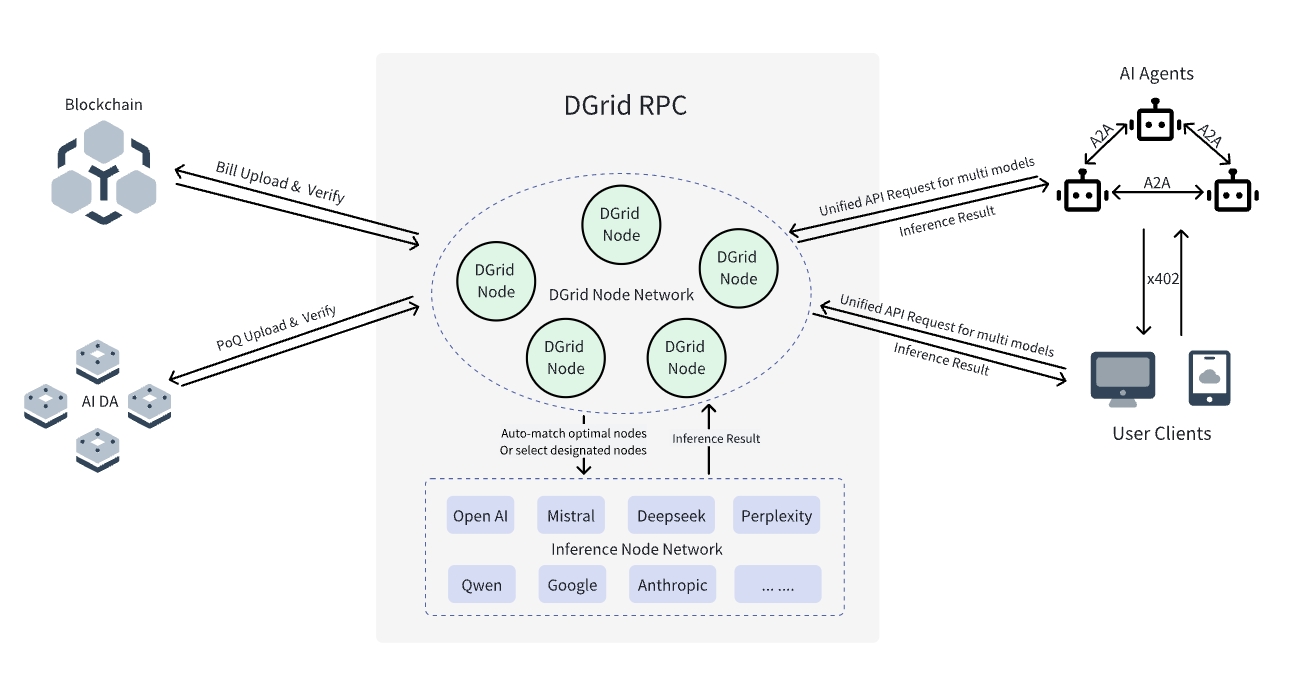DGrid's Solution
INFO
DGrid.AI = AI RPC + LLM Reasoning + Distributed Network Nodes
DGrid.AI addresses the critical gaps in Web3 AI and centralized AI limitations through an interconnected ecosystem of nodes, protocols, and decentralized infrastructure.
By integrating standardized AI RPC interfaces, distributed inference nodes, intelligent routing, on-chain settlement, and secure storage, it builds a trustless, scalable, and user-centric LLM inference network—making AI a native capability for blockchain applications. At its core, DGrid's solution redefines decentralized AI inference by integrating three foundational components: distributed nodes for model execution with Proof of Quality (PoQ) to guarantee result credibility, standardized protocols for universal access, and on-chain mechanisms for transparency.
Together, these elements eliminate reliance on centralized providers, enabling AI to operate as an open, community-governed utility.

DGrid Nodes: Decentralized Inference Execution
DGrid nodes are community-operated nodes that form the computational core of the network by integrating one or more large language models (LLMs, such as Llama-2, Mixtral). These nodes:
- Performs reasoning tasks for users by processing inputs (such as text prompts or smart contract queries) and generating outputs through preloaded models. Simultaneously, it validates the quality of reasoning results via the Proof of Quality (PoQ) mechanism to ensure the reliability and accuracy of the output.
- Adapt to hardware capabilities, with operators selecting models matching their server specs (from lightweight 7B-parameter models on basic GPUs to 70B+ models on high-performance hardware).
- Report metrics in real-time to DGrid adapter nodes (including latency and computational unit [CU] consumption), providing data support for intelligent routing and enabling optimal allocation of tasks.
By distributing inference across thousands of independent nodes, DGrid eliminates single points of failure and ensures geographic redundancy—critical for Web3 applications requiring 24/7 reliability.
DGridRPC: Universal Access and Request Verification
- DGridRPC: A standardized JSON-RPC protocol simplifying user access to models across the network. It provides a unified API for invoking any LLM (regardless of node or model type) and integrates EIP-712 signatures to validate user requests — ensuring only authorized and prepaid tasks are processed.
DGridRPC resolves the “interface fragmentation” issue in Web3 AI, making LLM integration as straightforward as calling a smart contract.
PoQ (Proof of Quality): Trustworthy Guarantee for Inference Results
PoQ (Proof of Quality) is the core mechanism in the DGrid ecosystem that ensures the credibility of LLM inference results. It operates in synergy with distributed nodes and GridRPC to form a closed loop of "request-execution-verification":
- Multi-dimensional Quality Assessment: PoQ conducts objective scoring on inference results generated by DGrid nodes based on three key dimensions: "Accuracy Match" (comparison with standard answers or reference results), "Response Consistency" (output deviation of the same request across different nodes), and "Format Compliance" (adherence to the output format requirements specified in user requests).
- On-chain Verifiable Proof Generation: After a node completes an inference task, it must upload the inference process logs and PoQ scoring data to the network to generate tamper-proof quality proofs. Users can query these proofs on-chain to quickly verify the reliability of results without re-executing the inference task.
Billing Contracts and AI DA Layer: On-Chain Transparency
- Billing Contract: A smart contract deployed on the blockchain to automate $DGAI token settlements between users and nodes. This contract calculates fees based on Computation Units (CU) and latency, deducts payments from user accounts via the x402 protocol, and distributes rewards to node operators—eliminating intermediaries.
- AI DA Layer (Data Availability): A decentralized storage network where all inference request data is PoQ-backed to ensure auditability. Users can verify billing details, while nodes can prove task completion, enhancing transparency for dispute resolution or compliance audits.
Security Mechanism
DGrid.AI has established a comprehensive security framework to ensure trustlessness in a decentralized network, combining technical safeguards and on-chain transparency:
Trusted Inference Environments
- Immutable Runtimes: DGrid Node operators cannot modify LLM weights or execution environments, ensuring consistent model behavior across the network.
- Resource Controls: Strict limits on CPU, GPU, and network usage (enforced by Nodes) prevent denial-of-service attacks.
On-Chain Auditing and Accountability
- Immutable Records: All critical activities—node registrations, inference metadata (inputs/outputs), fee settlements, and rewards—are recorded on-chain via the Bill Contract and archived in AI DA.
- Automated Penalties: DGrid Nodes monitor node behavior; malicious actors (e.g., submitting fake results) face staked token slashing or jailing, enforced by smart contracts.
- Decentralized Governance: $DGAI token holders vote on protocol upgrades, fee structures, and security parameters, ensuring the network evolves in line with community interests.
By combining secure inference environments, on-chain transparency, and community governance, DGrid.AI ensures the network operates in a secure, reliable, and trustless manner—delivering robust decentralized AI inference services to users.
dToken: Incentives & Governance
$DGAI (dToken) serves as the network’s economic engine, aligning interests across the ecosystem:
- Payments: Users pay $DGAI for inference tasks, with fees dynamically adjusted via the Bill Contract.
- Rewards: Node operators earn $DGAI based on contribution quality (e.g., low latency, high uptime) and validation participation.
- Staking: DGrid Nodes must stake $DGAI to participate, with slashing for misconduct.
- Governance: Token holders vote on protocol parameters (e.g., fee structures, model whitelisting) to guide network evolution.
This architecture delivers a solution that is scalable (anyone can operate a node),trustless (on-chain proofs replace reliance on intermediaries), and Web3-native (integrated with blockchain workflows). By unifying distributed execution, intelligent coordination, secure reasoning, and transparent settlement, DGrid.AItransforms LLM inference into a foundational capability for Web3—from DeFi strategy analyzers to on-chain chatbots and more.
